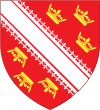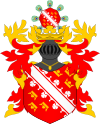Sundgau
| Sundgau | |
|---|---|
| Land Area | 663 km2 |
| Population | 61 841 inhabitants (1999) |
| Capital | Altkirch |
| Cantons | 4 |
| Communes | 112 |
Sundgau(French pronunciation:[suŋɡo][1][2]or[syŋɡo];[3][4]German:[ˈzʊntɡaʊ]) is a geographical territory in the southernAlsaceregion (Haut RhinandBelfort), on the eastern edge ofFrance.The name is derived fromAlemannic GermanSunt-gowe( "South shire" ), denoting anAlemannic countyin theOld High Germanperiod. The principal city and historical capital isAltkirch.
The considerably smaller Frenchpaysof Sundgau, implemented by the 1999 Loi Voynet, roughly corresponds to thearrondissement of Altkirch,comprising fourcantonsand 112communesin the south of the larger Sundgau region.
Geography
[edit]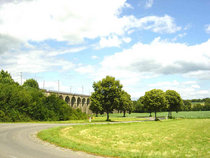
The hilly region is bounded on the south by theSwissborder and the foothills of theJura,in the east by the valley of theRhinein the vicinity ofBasel,to the north byMulhouseand the potassium-rich basin of Alsace, and to the west by theBelfortGap. It comprises parts of the modernDepartment of Haut-Rhinand theTerritory of Belfortin theregionsofAlsaceand theFranche-Comté.
The fertileloesssoil has traditionally favoured a non-specialisedagriculture,with crop production being largely organised into strips. The main crops aremaize,wheatandcolza.
TheIll,the most important river in Alsace aside from theRhine,crosses Sundgau from south to north before flowing into the Rhine nearStrasbourg.Its source is atWinkelin the foothills of the Jura. Other rivers define the region's valleys, such as the Largue, which rises nearCourtavon,passes throughDannemarie,and meets the Ill atIllfurth.
In medieval times, monks raisedcarpin the small valley ponds andcarpe frite(fried carp) remains a regional speciality. The images of two carp also appear in thecoat of armsof Sundgau.
Prehistory
[edit]Archaeological digshave revealed vestiges of palaeolithic andNeolithicsettlements. Traces ofBronze Agecremation pyres have also been found. Excavations atIllfurthdate from theIron Age(650 BC to 430 BC).
History
[edit]In the 1st century BC, theSequanitribe (the most "Gaulish ofGauls"according to historianHenri Martin), which was centered aroundBesançon,settled in Sundgau. From 70 BC, they waged perpetual warfare with their neighbours, theAedui,calling upon German mercenaries, led byAriovistus.When the conflict finished, the Germans settled into the region, and the Sequani, to remove them appealed to theRomans.Julius Caesardefeated Ariovistus in 58 BC nearCernay,and a long domination by the Romans commenced. This ended suddenly in 405, when the Alamani crossed the Rhine and occupied Sundgau. They, in turn, were followed by theFranksfollowing their victory at theBattle of Tolbiacin 496. Sundgau was incorporated into the kingdom ofAustrasiaandChristianitywas introduced under theMerovingians.
Francia
[edit]

About 750, theDuchy of Alsacewas divided into two counties: Nordgau (Unterelsass) and Sundgau, the latter being mentioned in theTreaty of Mersenin 870. Historically then, Sundgau coincides with the lands of the counts of Ferrette andHabsburg,excepting the town ofMulhouseand its territories ofIllzachandModenheim.Geographically, Sundgau denotes a more restricted area comprising the hilly country to the south of Mulhouse and reaching to the valley ofLucelle.
During the 9th century and the 10th century Sundgau was administered by theLieutfriedfamily. Following the breakup ofCharlemagne's empire, the region entered a period of instability, culminating in the emergence offeudalism.From 925 on, the Sundgau belonged to theDuchy of Swabia;it remained a part of Swabia until the Duchy disintegrated in the 13th century.
Holy Roman Empire
[edit]Landgraviate of Sundgau | |||||||||
|---|---|---|---|---|---|---|---|---|---|
| 750s–1648 | |||||||||
| Status | Stateof theHoly Roman Empire | ||||||||
| Capital | Altkirch | ||||||||
| Government | Principality | ||||||||
| Historical era | Middle Ages | ||||||||
•Alsacepartitioned in twain | 750s | ||||||||
•Landgraviateestablished | 750s | ||||||||
• ToHabsburgs | 1135 | ||||||||
• Sold toFrance | 1648 | ||||||||
| |||||||||
In 1125,Frederic,son ofTheodoric I of Montbéliard,inherited the south of Alsace and becameCount of Ferrette.So, from 1125 to 1324, a large part of the Sundgau was administered by the counts of Ferrette. Ulrich III (1310–1324) conquered the valley ofSaint-Amarinbut died with no maleissue.His daughter Jeanne marriedAlbert II, Duke of Austriain 1324, and the County of Ferrette fell to Austria and was integrated with the other Habsburg possessions in the area.
TheLandgraviateof Sundgau(also known asLandgraviate of Upper Alsace), the successor of the Carolingian county, had been administered by the counts ofHabsburgsince 1135. They had owned the adjacent County of Sundgau even earlier. The Habsburgs enlarged their possessions in the area with numerous acquisitions in the following centuries, until by the mid-14th century almost all of the former Carolingian county was in the possession of Habsburg. Their consolidated territories in the area became known simply as the Sundgau, and belonged to theAustrian Circleof the Empire after 1512. The Habsburgian Sundgau was administered fromEnsisheimby abailli(bailifforseneschal) and divided into four bailiwicks (Landser,Thann,AltkirchandFerrette).Enguerrand VII, Lord of Coucytried unsuccessfully to claim the Sundgau during theGugler Warof 1375.
As of 1500, the Austrian Sundgau encompassed most of the southern Alsace and was bordered by the following states (from the north, clockwise): Imperial City ofColmar,County of Württemberg,the AustrianBreisgau,theMargraviate of Baden,the Imperial City ofBasel,thePrince-Bishopric of Basel,the County of Württemberg (County of Montbéliard), theDuchy of Lorraine,theAbbacy of Murbach,and thePrince-Bishopric of Strasbourg(theMundat). The Imperial City ofMulhouseformed an enclave surrounded by the Sundgau.

TheReformationdid not trouble Sundgau, despite the proximity of Basel and Mulhouse. The country maintained its fidelity to the religion of theHabsburgs,Catholicism.
Commencing in 1632, theThirty Years' Warbroke upon Sundgau, with a violence unprecedented in the history of the region. TheSwedish,supported by France, invaded the country, pillaging and burning all in their path. In reaction, the inhabitants of the countryside revolted. But the rebellion was subdued, and the Swedes hanged the ringleaders from roadside trees. From 1634, the Swedes ceded their fortresses to the French, and in 1648 the war ended with theTreaty of Westphalia.The butcher's bill was disastrous – some parts of Sundgau had lost up to 80% of their population. The country, only German speaking at that time, was conquered and annexed by France, and in 1659, the counthood of Ferrette was granted toCardinal Mazarin(nominally by the then 21-year-oldLouis XIV).
France and Germany
[edit]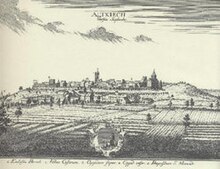
The beginning of the 18th century was a period of prosperity with the development of agriculture andtextile industry.But economic and social conditions deteriorated in the second half of the century, with overpowering taxation, and occasional famines.
In 1789, the repercussions of theFrench Revolutionreached Sundgau, and many conflicts arose in the townships, mainly due to the unpopularity of theruling classes.In 1790, Sundgau was included into the département ofHaut-Rhin,and Altkirch became its principal town.
Order was restored during theConsulateand theEmpire.Little changed during the 19th century, agriculture remaining the principal economic activity, despite the establishment of industries such as the Gilardoni tileworks in 1835 and the construction of Xavier Jourdains' looms in Altkirch.
As a result of the 1870Franco-Prussian War,Sundgau returned toGermanyas part of the Imperial territory ofAlsace-Lorraine.Economic developmentpicked up, and the region opened up to the rest of Alsace, for want of trade with France.
The battles of theFirst World Warcommenced in Sundgau in August 1914. The French blew up the viaduct ofDannemarie,and the front stabilised and extended from theVosgesto the Swiss frontier. The population suffered artillery bombardments and, for fear of spying, many were evacuated into those communes untouched by war.
Sundgau reverted to France in 1918, but its reintegration posed several problems; since Alsace wasGermanspeaking, they now saw themselves obliged to express themselves inFrench.By way of derogation, German was taught in schools for three hours a week. The administration was only inFrenchand the mayor was appointed by the French government.
Between the wars, 56% of the population worked in agriculture, 28% inindustryand only 7% inservices.
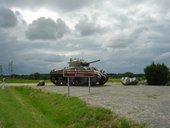
In theSecond World Warafter the declaration of war, the communes bordering on the Rhine were evacuated. The German army crossed the river on 15 June 1940. Following theArmisticeof 22 June, Sundgau was once again in German hands. ElsaßianJews,a fewNorth Africansand French-speakers were expelled to thefree zonebetween it andVichy France.Pre-1918 German names of communes were restored, and the school system reverted to speaking only German. Youngsters were enrolled inHitler Youthfrom 1942.
From then also, men born between 1914 and 1925 were drafted in theWehrmacht.
GeneralJean de Lattre de Tassigny's troops reached the Sundgau in November 1944, with Seppois-le-Bas (Nieder Seppbach) being the first. As after the first World War, language issues arose. From 1945 to 1984 the use of German in newspapers was restricted to a maximum of 25% (despite the fact that the population was still mainly German speaking).
Post-war, there was a period of reconstruction and economic growth.Jean Fourastié'sTrente Glorieuses,the thirty years of economic growth 1945 to 1973, ended by the firstOil Crisis,and the number of agricultural workers dropped year by year. More than 35% of the population currently work in services.
Organisation
[edit]Sundgau is anarrondissement(thearrondissement of Altkirch) and is divided into 4 cantons: Dannemarie, Altkirch, Hirsingue and Ferrette. These run roughly along a north–south axis (see map) and consist of 112 communes. These communes are in turn grouped into 8 communities and one village (Bernwiller) for economic and tourism promotion purposes.
- The Community of communes of Porte d'Alsace: 33 communes
- The Community of communes of Alsatian Jura: 24 communes
- The Community of communes of Illfurth: 10 communes
- The Community of communes of Valley of the Largue: 9 communes
- The Community of communes of Altkirch: 4 communes
- The Community of communes of Hirsingue: 11 communes
- The Community of communes of Valley of Hundsbach: 12 communes
- The Community of communes of Ill and Gersbach: 9 communes
Population
[edit]Thepopulationreached 61,841 inhabitants in 1999 (up from 57,112 in 1990), an increase of 8.3%. Thus it paralleled thedemographicgrowth both of Haut-Rhin (which showed an increase of 5.3% in the same period), and, more broadly, that of Alsace itself, (which showed an increase of 6.8%).
Altkirchis the most populous of Sundgauvien communes, with 5,386 inhabitants (1999). This is followed byHirsingue(2,057 inhabitants), thenDannemarie(2,011 inhabitants). Notably, 70% of the population is spread out among 103 communes of less than 1,000 inhabitants each. Finally, 19.2% of the inhabitants are aged under 15, while 19.3% are over 60. As in the remainder of France, the proportion of over-60s is growing.
Economy
[edit]Sundgau remains primarily an agricultural region with traditional activities. Important urban centres immediately outside Sundgau such as the tri-nationalconurbationofBasel,the urbanised area ofBelfort-Montbéliard-Sochaux,and theMulhouseconurbation, are attractive as providers of goods, services, and employment. Qualifications are lower and revenues higher as a result of border area employment and its economic and social impact.
Nevertheless, Sundgau remains underequipped, notably for company startups. Although several enterprises have started during the last ten years, it is not sufficiently attractive as an employment basin because of the counterattractions of the nearby conurbations.
Transport
[edit]Road network
[edit]Sundgau is ringed by major roads, such as the A36motorwaybetween Belfort and Mulhouse, and the A35 toll-road, between Mulhouse and Basel; nevertheless, the elected representatives agree that the road network is outdated. Other important roadways are the D419, crossing the region from east to west between Belfort and Basel and passing through Dannemarie and Altkirch, and the North-South D432, passing through Illfurth, Altkirch, Hirsingue and Ferrette.
Several current projects aim at improving the road network and bypassing villages. These include diversions at Retzwiller and Dannemarie, and the Spechbach-le-Bas and Hochstatt bypasses. Another large project, the extension of the rapid road from Dornach as far as Altkirch, is under discussion.
Railway network
[edit]The Paris-Bâleline serves the towns of Dannemarie, Altkirch and Illfurth. Regional trains are relatively frequent, and useful for Sundgauviens working in Mulhouse or Belfort. Work on a Dijon-Mulhouse line of theTGVRhine-Rhône isplanned to startin 2006.
Canal network
[edit]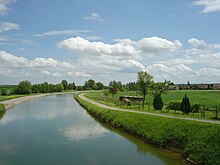
Thecanalfrom the Rhône to the Rhine crosses Sundgau by Montreux-Vieux, Dannemarie and Illfurth. It has existed since 1824 and was conceived byFreycinet.Nowadays, it is too narrow for large barges and serves mainly for pleasure craft.
A large project for the construction of a canal linking the Rhine to the Saône, passing along the Doubs, has been abandoned. Indirectly, it would have linked central Europe (Rhine,Danube,North SeaandBaltic Sea) to theMediterraneanwithout having to ship merchandise through theStraits of Gibraltar.But the anger of agriculturalists and environmentalists influenced the Minister of the Environment to abandon the project in 1998.
Tourism
[edit]The General Council of Haut-Rhin has taken an interest in Sundgau and in developing tourism in the region since 2000, along the lines of the management of the source of the Ill or the construction of a rest area on the route D419 near Chavannes-sur-l'étang. Sundgau is a region where the lifestyle permits the development ofGreen Tourism(i.e. where the visitor seeks calm, wishes to be in direct contact with nature, and has activities such as countryside walks and drives available).
Heritage
[edit]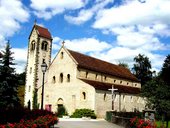
- Château of Ferrette, the château of the counts of Ferrette
- Château of Morimont
- Château of Landskron
- Hundsbach Mill
- Ancient Cistercian abbey of Lucelle, destroyed during the Revolution, and rebuilt as a hotel
- Romanesque church of Feldbach
- Romanesque church of Altkirch
- Sundgauvien museum in Altkirch
- Hirtzbach (the village won 4 flowers in a national competition organised by theConseil pour le Fleurissement de la Francewhich promotes flower-planting)
Notable Sundgauviens
[edit]- Xavier Jourdain,textile industrialist (1798–1866)
- Jean-Jacques Henner,painter (1829–1905)
- Charles Zumstein,farmer-poet, diviner (1867-1963)
- Dominik Richert,author of memoirs of the First World War (1893-1977 )
- Félis Voulot,sculptor (1899–1905)
- Daniel Zimmermann, novelist,educator (1935–2000)
Nathan Katz 1892- 1981 poet
References
[edit]- ^La 15e édition des Carpailles dans le Sundgau,archivedfrom the original on 2021-12-21,retrieved2021-09-08
- ^Sundgau: des incendies criminels visent les antennes-relais,archivedfrom the original on 2021-12-21,retrieved2021-09-08
- ^Le Sundgau, terre solaire?,archivedfrom the original on 2021-12-21,retrieved2021-09-08
- ^Dans le Sundgau, la carpe frite se déguste... en glace,archivedfrom the original on 2021-12-21,retrieved2021-09-08
Bibliography
[edit]- Claude Stadelmann,Le merveilleux existe. Contes et légendes du Sundgau,2005
External links
[edit]- (in French)Historical Society of Sundgau
- (in French)Events in Sundgau and AltkirchArchived2020-09-29 at theWayback Machine
- (in German and French)Alsace and Sundgau website
- a detailed Alsatian Jura website
- (in French)the Sundgau through the wars

